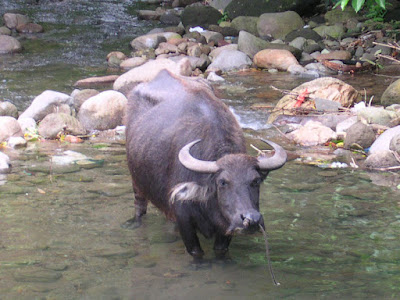Reading Notes: The Iguana and the Turtle
I like this fun and interesting story of reptiles. It is a folk tale commonly narrated in the Philippine island of Pangasinanes.
It's interesting how two completely reptiles, iguana and turtle, could be close friends. It begins with a very interesting plot. Old man, who is a human, captured turtle because he wanted turtle to marry his daughter. The imagination of the Filipino people is truly amazing.
I also like this sudden turn-around of the plot: "Now, the iguana very much wanted a wife, and he was delighted at this chance. So he asked the turtle to be allowed to take his place. The turtle consented. So the iguana released the turtle and was tied up in his place. Then the turtle made off as fast as he could." It's really cool to have two characters who have different personalities and personal interests such as wife and marriage.
I could literally imagine so vividly in my head of this scene: "When the old man woke up, he heard someone saying over and over again, 'I want to marry your daughter.' He became angry and went down under the house to see who was talking. There he found the iguana saying, 'I want to marry your daughter.' The old man picked up a big stick to beat its head, but the iguana cut the string and ran away."
This story is all about being alert and clever and warns naivety and foolishness. Yet again, Iguana was very naive and fooled again by his turtle friend: "The iguana wanted to see the turtle’s grandfather, so he climbed up the tree and put his mouth between the two bamboos that were rubbing together. His mouth was badly pinched, and he fell down to the ground. The turtle meanwhile had disappeared."
The iguana character is depicted as a rather foolish character that is naive, greedy, and easily deceived, whereas turtle is portrayed, although not good-natured in my opinion, as a clever and shrewd animal who can adeptly respond to crises.
Obviously, this story teaches an important lesson: The one who believes foolishly without thinking will be injured.
It was really fascinating to read about this simple, yet powerful and educational Filipino folktale.
Bibliography:
Filipino Popular Tales by Dean S. Fansler (1921).
It's interesting how two completely reptiles, iguana and turtle, could be close friends. It begins with a very interesting plot. Old man, who is a human, captured turtle because he wanted turtle to marry his daughter. The imagination of the Filipino people is truly amazing.
I also like this sudden turn-around of the plot: "Now, the iguana very much wanted a wife, and he was delighted at this chance. So he asked the turtle to be allowed to take his place. The turtle consented. So the iguana released the turtle and was tied up in his place. Then the turtle made off as fast as he could." It's really cool to have two characters who have different personalities and personal interests such as wife and marriage.
I could literally imagine so vividly in my head of this scene: "When the old man woke up, he heard someone saying over and over again, 'I want to marry your daughter.' He became angry and went down under the house to see who was talking. There he found the iguana saying, 'I want to marry your daughter.' The old man picked up a big stick to beat its head, but the iguana cut the string and ran away."
This story is all about being alert and clever and warns naivety and foolishness. Yet again, Iguana was very naive and fooled again by his turtle friend: "The iguana wanted to see the turtle’s grandfather, so he climbed up the tree and put his mouth between the two bamboos that were rubbing together. His mouth was badly pinched, and he fell down to the ground. The turtle meanwhile had disappeared."
The iguana character is depicted as a rather foolish character that is naive, greedy, and easily deceived, whereas turtle is portrayed, although not good-natured in my opinion, as a clever and shrewd animal who can adeptly respond to crises.
Obviously, this story teaches an important lesson: The one who believes foolishly without thinking will be injured.
Image of an Iguana. Source: Iguana
Bibliography:
Filipino Popular Tales by Dean S. Fansler (1921).




Comments
Post a Comment